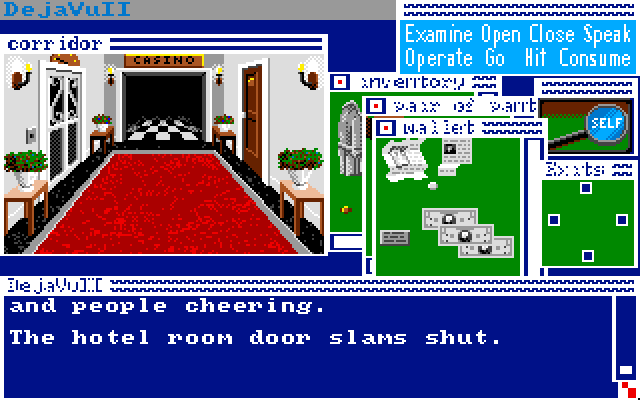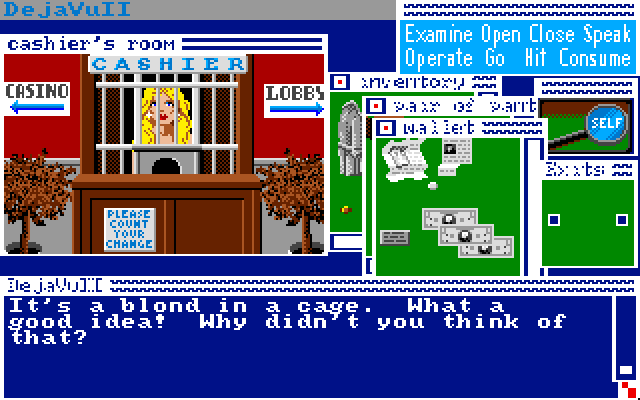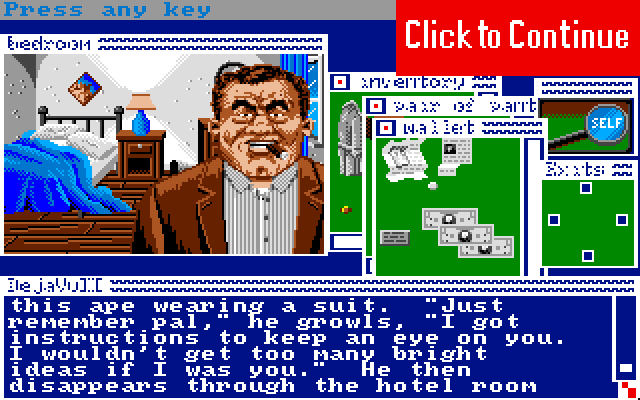|
 aking
up in a Las Vegas hotel with a splitting headache is
guaranteed to send shivers down the spine. Did you really
bet your life savings on roulette last night? A glance
in the mirror brings ugly memories flooding back: the
name's Ace Harding, private dick, and mobster Tony Malone
believes you owe him $112,000. aking
up in a Las Vegas hotel with a splitting headache is
guaranteed to send shivers down the spine. Did you really
bet your life savings on roulette last night? A glance
in the mirror brings ugly memories flooding back: the
name's Ace Harding, private dick, and mobster Tony Malone
believes you owe him $112,000.
Not
even you could lose that amount of money gambling, instead
it's all to do with your previous adventure when you
were acquitted of the murder of one of Malone's leg
men. Your splitting headache comes from a 'friendly'
discussion with Mr Malone, and his henchmen, last night.
If you don't find his hundred and twelve grand within
the next week he'll put more perforations in you than
a Tetley tea bag, letting the flavour flood out (along
with your blood).

Fancy
a gamble in the casino?
During
the week you're free to wander around Vegas, but just
to make sure you don't make a quick getaway, Malone
has ordered Stogie Martin to keep an eye on you. Stogie
resembles King Kong in a suit, so it's wise not to cross
him.
Leaving
your room, you're unsurprised to find that the 'Lucky
Dice' hotel has its own casino, where you can play blackjack
against any of five house players or try your luck on
the fruit machines. However, getting out of the hotel
isn't easy -- the only two methods I found are to either
hit someone or take off your trenchcoat and trousers!

.
. . because I'm not a sexist.
Once
outside, you find Las Vegas has changed a bit -- apart
from the hotel and a railway station there's nothing
but desert. Thankfully trains leave to Los Angeles,
St Louis, New York and your home town -- Chicago --
but for Stogie there's no place like home, and he'll
shoot you if you go anywhere else. Travelling around
Chicago is by taxi with a deaf driver who needs to be
shown where you want to go. This is where the real adventuring
takes place, as you explore seedy underworld locations
in an attempt to recover Malone's dough.
As
in the original Deja Vu, Ace Harding is controlled
using a simple menu of just eight basic commands. Every
location has a beautifully detailed picture which can
be examined by clicking on various things. Objects are
taken by simply dragging them from the picture into
the inventory window. In addition, some items (coats,
drawers etc) may he opened to reveal further windows
(containing their contents). Windows can be closed,
moved around the screen and expanded/contracted.

Communication
with other characters is limited to a simple speak command
-- this is the only time input is directly typed in.
But most characters encountered aren't exactly conversationalists
and will only respond to strictly limited input.
The
menu/window system is a pleasure to use and eliminates
the problems caused by obscure vocabulary in normal
adventures -- with a limited set of commands all problems
must be solved by lateral thinking instead of word guessing.
Clues to the mystery of the missing dosh are hidden
everywhere and you'll have a wonderful time interpreting
them. Location descriptions are brief (to fit into the
smallish window) but contain plenty of acidic humour,
and complement the truly excellent graphics to create
a fine atmosphere, enhanced by occasional, but good,
sound effects.
Deja
Vu II is a worthy follow-up to the excellent, innovative
original.
|